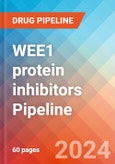WEE1 protein inhibitors Understanding
WEE1 protein inhibitors: Overview
WEE1 is a key regulator of the cell cycle that has been a target of cancer drug discovery efforts for more than a decade. The WEE1 kinase family consists of three serine/threonine kinases sharing conserved molecular structures and encoded by the following genes: WEE1 (WEE1 G2 Checkpoint Kinase), PKMYT1 (membrane-associated tyrosine- and threonine-specific cdc2-inhibitory kinase), and WEE1B (WEE2 oocyte meiosis inhibiting kinase). Wee1-like protein kinase is a tyrosine kinase with a key role as an inhibitory regulator of the G2/M checkpoint that precedes entry into mitosis. Abrogation of this checkpoint through Wee1 inhibition may result in increased antitumor activity of agents that cause DNA damage such as radiation therapy or some cytotoxic agents. This has been confirmed in preclinical studies and results of clinical studies evaluating a Wee1 inhibitor are awaited to establish its activity in combination with chemotherapy.'WEE1 protein inhibitors - Pipeline Insight, 2025' report outlays comprehensive insights of present scenario and growth prospects across the indication. A detailed picture of the WEE1 protein inhibitors pipeline landscape is provided which includes the disease overview and WEE1 protein inhibitors treatment guidelines. The assessment part of the report embraces, in depth WEE1 protein inhibitors commercial assessment and clinical assessment of the pipeline products under development. In the report, detailed description of the drug is given which includes mechanism of action of the drug, clinical studies, NDA approvals (if any), and product development activities comprising the technology, WEE1 protein inhibitors collaborations, licensing, mergers and acquisition, funding, designations and other product related details.
Report Highlights
The companies and academics are working to assess challenges and seek opportunities that could influence WEE1 protein inhibitors R&D. The therapies under development are focused on novel approaches to treat/improve WEE1 protein inhibitors.WEE1 protein inhibitors Emerging Drugs Chapters
This segment of the WEE1 protein inhibitors report encloses its detailed analysis of various drugs in different stages of clinical development, including phase II, I, preclinical and Discovery. It also helps to understand clinical trial details, expressive pharmacological action, agreements and collaborations, and the latest news and press releases.WEE1 protein inhibitors Emerging Drugs
Adavosertib: AstraZeneca
Adavosertib selectively targets and inhibits WEE1, which prevents the phosphorylation of CDC2 and impairs the G2 DNA damage checkpoint. WEE1 phosphorylates cyclin-dependent kinase 2 (CDC2) to inactivate the CDC2/cyclin B complex, regulating the G2 DNA damage checkpoint. The drug is currently in the Phase II stage of clinical trial evaluation to treat Ovarian Cancer. AZD1775 has received Orphan Drug designation in the European Union for this indication.WEE1 protein inhibitors: Therapeutic Assessment
This segment of the report provides insights about the different WEE1 protein inhibitors drugs segregated based on following parameters that define the scope of the report, such as:Major Players in WEE1 protein inhibitors
There are approx. 5+ key companies which are developing the therapies for WEE1 protein inhibitors. The companies which have their WEE1 protein inhibitors drug candidates in the most advanced stage, i.e. phase II include AstraZeneca.Phases
The report covers around 5+ products under different phases of clinical development like
- Late stage products (Phase III)
- Mid-stage products (Phase II)
- Early-stage product (Phase I) along with the details of
- Pre-clinical and Discovery stage candidates
- Discontinued & Inactive candidates
Route of Administration
WEE1 protein inhibitors pipeline report provides the therapeutic assessment of the pipeline drugs by the Route of Administration. Products have been categorized under various ROAs such as- Subcutaneous
- Intravenous
- Intramuscular
Molecule Type
Products have been categorized under various Molecule types such as
- Peptides
- Polymer
- Small molecule
Product Type
Drugs have been categorized under various product types like Mono, Combination and Mono/Combination.WEE1 protein inhibitors: Pipeline Development Activities
The report provides insights into different therapeutic candidates in phase II, I, preclinical and discovery stage. It also analyses WEE1 protein inhibitors therapeutic drugs key players involved in developing key drugs.Pipeline Development Activities
The report covers the detailed information of collaborations, acquisition and merger, licensing along with a thorough therapeutic assessment of emerging WEE1 protein inhibitors drugs.WEE1 protein inhibitors Report Insights
- WEE1 protein inhibitors Pipeline Analysis
- Therapeutic Assessment
- Unmet Needs
- Impact of Drugs
WEE1 protein inhibitors Report Assessment
- Pipeline Product Profiles
- Therapeutic Assessment
- Pipeline Assessment
- Inactive drugs assessment
- Unmet Needs
Key Questions
Current Treatment Scenario and Emerging Therapies:
- How many companies are developing WEE1 protein inhibitors drugs?
- How many WEE1 protein inhibitors drugs are developed by each company?
- How many emerging drugs are in mid-stage, and late-stage of development for the treatment of WEE1 protein inhibitors?
- What are the key collaborations (Industry-Industry, Industry-Academia), Mergers and acquisitions, licensing activities related to the WEE1 protein inhibitors therapeutics?
- What are the recent trends, drug types and novel technologies developed to overcome the limitation of existing therapies?
- What are the clinical studies going on for WEE1 protein inhibitors and their status?
- What are the key designations that have been granted to the emerging drugs?
This product will be delivered within 2 business days.
Table of Contents
Companies Mentioned (Partial List)
A selection of companies mentioned in this report includes, but is not limited to:
- Debiopharm
- AstraZeneca
- Zentalis Pharmaceuticals
- Nuvation Bio
- Impact Therapeutics
- Schrdinger








